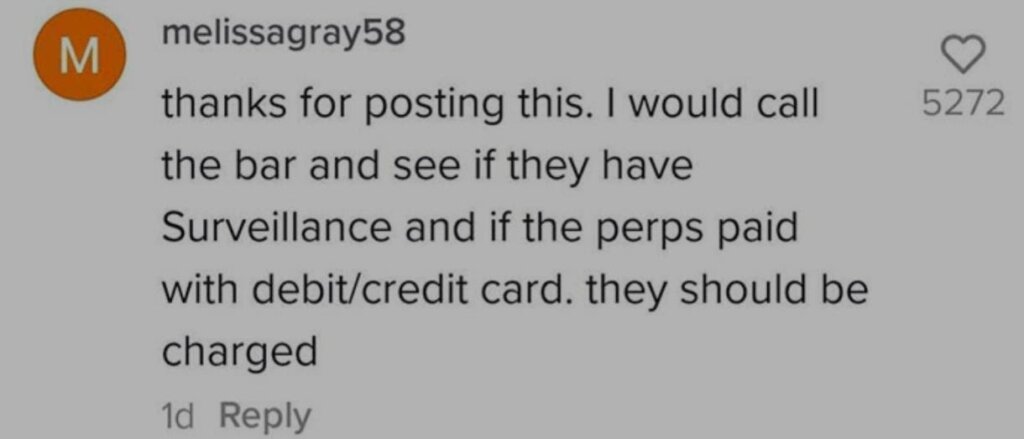TikTok User Shares Her Horrible Experience She Had Along With Her Friend
This is so common nowadays for women to get harassed. It is highly unlikely that there are any women who did not have such a bad experience. Some of the experiences of this lady are mentioned in this article.
Women are given drugs in the drinks, they lose control of their senses and can not defend themselves. That person can be anyone, someone you know, or someone you don’t know. aili.likes.adventure shares her horrific experiences on TikTok to create awareness.
She said that once she and her friend went out, a group of males started to harass them. Here is the story of her experience;
TikTok is a social networking website that has more than 34 languages and 150 million active users. This is one of the most popular social sites for teenagers nowadays.
Apart from its endearing features and effects, which are popular among teenagers, the video streaming software TikTok is allegedly spreading sexually explicit information involving children, which is hazardous to youngsters.
According to reports, the video streaming app is attempting to persuade children who are infatuated with social media and badly want to engage or get followers, as well as to trap minors. Here are a few more Tik Tok facts for parents to be aware of:
This software is growing in popularity, yet its services are constantly sexually exploiting youngsters online. Many sexual predators are active on TikTok and prey on teenagers and children.
TikTok is a video streaming app that allows young children to upload short movies of up to 60 seconds in length with the effects of digital filters and stickers, making it appealing to children.
It has been ranked as the fourth most downloaded app in the year 2018. Because of this, sexual predators have targeted youngsters as young as eight years old.
TikTok is extremely popular among young children and teenagers, and many of them have become addicted to it. There are a number of sexual predators who prey on youths and children in the TikTok comment section for engaging in sexual conduct.
Due to a lack of security settings on children’s cell phones, children are able to post live recordings of themselves and, as a result, become ensnared by child abusers online. Here are some of the reasons why Tik Tok is hazardous:
TikTok, a live-streaming app, has been penalized for violating the privacy and data of thirteen-year-old children without parental agreement. It cannot even suspend the private accounts of specific people accused of sexually grooming teenagers.
The engineers and product designers try their best to assist them to reach their business goals, but their decisions may have unforeseen repercussions.
When a young teen creates a short video of herself that is unacceptable to share on social media platforms, she appears offended and horrible. Other viewers have seen the movie several times, and the live broadcast allows users to comment in the comment section.
TikTok is exposing young kids to online sexual harassment. Furthermore, kids are expressing their own sexual fantasies, and at the end of the day, a young mind was sexually groomed by online sexual predators.
Despite being a popular music app, it is impossible to suspend the accounts of sexual predators who use their accounts to send sexual messages to young teens and children.
That is why parents must take strong measures to protect their children and keep them safe on this platform. These are some precautions that parents can take to protect their children:
Parents may teach their children and teenagers how to filter out inappropriate content on the app and be safe. You should advise young kids to make their accounts private so that only the producer of the video may view the videos on the app.
The private account also allows young users to approve and restrict incoming messages from sexual predators or strangers.
Apart from that, parents should utilize parental control software for their cell phones, which gives them a plethora of tools for monitoring their children’s and teens’ activities on the live streaming app by using the TikTok screen recorder.
Which has nearly 500,000 likes and urges girls to record themselves placing one finger down for every time they have been sent unsolicited dick images, begged for nudes, catcalled, repeatedly asked out after saying no, and pushed to do something sexual when they didn’t want to.
Table of Contents
A Traumatic Experience

Being Harassed by Men At Bar

In 2020, similar videos depicting sexual assault posted by young women became popular. The latest film, intended for teenagers, is about sexual harassment. The “Put a finger down: Sexual harassment edition” video has become the 2021 TikTok adolescent equivalent of the 2017 #MeToo movement by drawing attention to how widespread sexual harassment is among teen girls.
Drinking With Friends

This trend combines two practically universal aspects in teen girls’ lives: the pervasive availability of social media and the daily barrage of sexual harassment. As a developmental psychologist, I believe this tendency demonstrates how teens have created a new method of dealing with a long-standing issue.
Men Sit With Us

Pew Research conducted a poll on COVID-19 and discovered that nearly half of the youths in the United States reported being online “almost continuously.”
Teens relied on social media, even more, this year while locked at home during remote schooling to cope with the forced social isolation.
Lockdowns and remote learning are especially uncomfortable for teenagers, who are in a developmental stage in which the demand to connect with peers is at an all-time high.
Excited To Share The Leg With Her Friend

Frustrating men
At the same time as kids are spending more time on social media, the content of what they are posting has grown increasingly focused on social concerns and “real-life” challenges and worries.
It stands to reason, then, that a popular social media post addresses one of the most stressful aspects of adolescent girls’ lives: sexual harassment.
According to research with middle and high school girls, in fifth grade, one out of every four teenagers has encountered sexual harassment in the form of sexual comments, jokes, gestures, or looks.
By the eighth grade, it is one in every two. My colleagues and I discovered that by the end of high school, 90% of girls have experienced sexual harassment at least once.

Having Drink Given To A Women Is Not Okay
It happens so frequently, and in such public places as corridors and cafeterias, that by middle school, nearly all students (96 percent) had witnessed sexual harassment at school.
If it’s not in the school, it’s on their phones: four out of every five teen girls have had at least one acquaintance who has been asked by a boy to provide a “sexy or naked” picture.

They Were So ill Mannered
These sexual harassment incidents do not leave girls unaffected. Girls report feeling “filthy — like a piece of trash,” “terrible,” “scared,” “sad and angry,” and “like a second-class citizen” as a result of sexual harassment. Seventy-six percent of girls say they feel unsafe because they are girls at least occasionally.

It Was Kind Of Concerning For Us

aili.likes.adventure Sharing Her Experience

The more sexual harassment girls face, the more likely girls are to experience emotional distress, melancholy, and shame, as well as low self-esteem, substance addiction, and suicide ideation. Their attitudes toward their bodies deteriorate, with many girls disliking their own bodies and engaging in eating behaviors that lead to eating disorders. And the more sexual harassment girls face, the more probable it is that they will suffer in school, be absent more frequently, and withdraw from academics.
Shoved Back The Beers In His Hand

Despite the harm it causes, girls rarely share their experiences. Despite reporting emotions of insecurity, anger, helplessness, and embarrassment, kids seldom report the harassment to educators or parents and rarely urge the harassers to stop, according to concerns about the social consequences.
Stunned When He Declined The Drink

More than 60% of adolescent girls are concerned about retaliation, or “that the other person might try to get back at” them if they confront or report the harasser.
More than half of females are concerned that if they say something, people will assume they are “trying to cause trouble” or “just being emotional.” Half of them believe they will not be believed.
Went To My Friend And Asked Her To Leave

Worst Experience And Warn Others
Instead of speaking up, more than 60% of young girls say they try to “forget about” or “ignore” the harassment, dismissing it as “simply part of being a girl.” The issue with ignoring sexual harassment is that it does not work.
Decades of study on the most effective ways to cope with stressful events has revealed that seeking social support and confronting the source of the stress are far more successful coping techniques than downplaying or ignoring the problem.
Eye Contact With Those Men
Instead of speaking up, more than 60% of young girls say they try to “forget about” or “ignore” the harassment, dismissing it as “simply part of being a girl.” The issue with ignoring sexual harassment is that it does not work.
Decades of study on the most effective ways to cope with stressful events have revealed that seeking social support and confronting the source of the stress are far more successful coping techniques than downplaying or ignoring the problem.
So, while the latest social media hashtag craze may appear insignificant, discussing sexual harassment experiences in a TikTok video is likely to be really beneficial. Teens utilize social media to communicate with one another.
Although passively scrolling through others’ social media feeds can lead to people negatively comparing themselves with others, which can contribute to feeling envious of others’ seemingly better lives, research has shown that actively using social media – by posting their own thoughts – can increase a person’s sense of social connections.

Kindly Create Awareness Among Other Woman

In turn, social connectedness leads to increased psychological well-being. This social media effect appears to be especially true for females: in studies where girls used social media to openly discuss themselves, they reported more social support, and their well-being and positive moods improved.
Another Possibility

This sense of genuine social connection is especially crucial for kids who have experienced sexual harassment. Our research has found that when teen females believe their peers support them, they are more likely to stand up for themselves and confront perpetrators of sexual harassment.
If honest disclosures about their experiences on social media make teen girls feel connected with others, they may feel empowered to say something in real life as well.
Both of Them Just Wanted to Share and Educate Others

This latest social media trend undoubtedly benefits the individuals watching the films as well as the girls who make the videos. The 2017 #MeToo campaign encouraged more than half of adolescent girls to notify someone about what had occurred to them. It made them feel less isolated.
Irony!

It also aids in labelling these prevalent daily activities as problematic. It is important for girls to understand that this does not have to be a “part of life.”
It is also beneficial for boys to see that certain habits do not flatter girls. According to our findings, boys sexually harass girls mostly because their peers do so and it has become the norm.
They frequently believe that this is how boys are supposed to demonstrate love interest. Boys are rarely taught about sexual harassment, and they frequently fail to recognize how hurtful it is for women.
Ask For CCTV Recording

Be Safe!

Stay Safe Everyone








